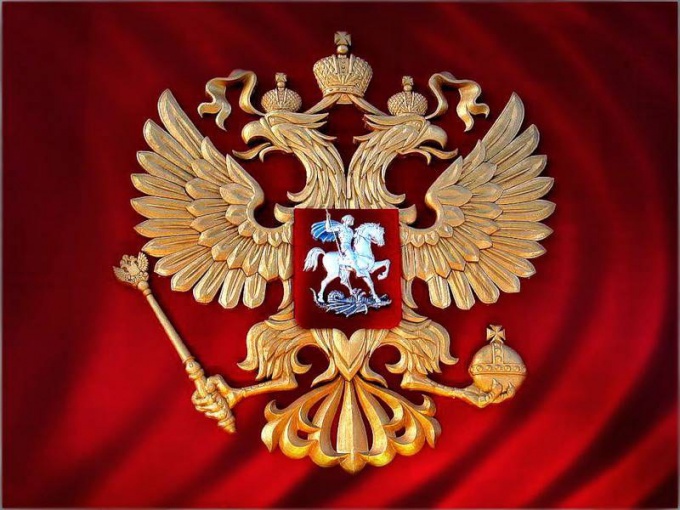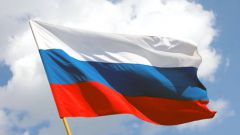Feature the Russian coat of arms is that the eagle depicted on it that has two heads facing in different directions. This way can not be considered exclusively a Russian – he was known to the Sumerian civilization, the Hittites. He existed in Byzantium.
The most famous theory connects the origin of the Russian coat of arms a double-headed eagle from Byzantium. It is believed that this coat of arms "brought" in Russia, Sophia Palaeologus, the niece and sole heiress of the last Byzantine Emperor. Marrying Sophia, Grand Prince of Moscow Ivan III had every reason to consider himself the heir of Byzantine emperors, who died under the blows of the Turks, and, together with the title of Emperor and inherited the coat of arms a double-headed eagle.
This hypothesis contradicts many facts. Wedding of Ivan III and Sophia Palaeologus took place in 1472, and the double-headed eagle was adopted as the state emblems (the print) in 1497. It is difficult to find a causal relationship between events separated by 25 years.
There is no reason to believe that the double-headed eagle was the emblem of the Palaeologus and especially the Byzantine Empire as a whole. This symbol was not on Byzantine coins, either at the state seals. And yet, this symbol was used as a decor item. Garments with this symbol worn by high nobility.
As a coat of arms double-headed eagle was not used in Byzantium and its neighboring countries – Bulgaria, Serbia, Romania, who sought to oppose her.
Some researchers have attributed the origin of the double-headed eagle on the Russian coat of arms with the Golden Horde. This symbol is present on the coins of Janibek, who ruled in the 14th century. But this theory is controversial: the borrowing of the enemy's emblem is unlikely.
More reasonable seems the hypothesis of borrowing the double-headed eagle of Western Europe. In medieval Europe, the double-headed eagle was present on the coins of Frederick Barbarossa, Bertrand III, the king of Bohemia Wenceslas IV, and from 1434 it was the state emblem of the Holy Roman Empire.
Ivan III took a course on strengthening of the international prestige of the young Moscow state. It is measures such as issuing gold coins, the introduction of European elements in the court ceremonial. It is possible that the adoption of the eagle as the emblem was also connected with the desire to become level with the European monarchs, especially Emperor of the Holy Roman Empire.
In Europe, the double-headed eagle appeared in the late 12th century – in the era of the Crusades. Probably it was during the Crusades, this symbol was borrowed by the Europeans in the East. In Eastern culture it was conceived in antiquity – initially as an element of the ornament, later becoming a symbol of Royal power. Two heads of an eagle appeared as the adherence to the principle of symmetry, which in Eastern culture was associated with the idea of perfection, which was correlated with the understanding of the ruler as a "model of perfection".
As the Russian coat of arms image of the eagle filled with new content. It was seen as a symbol of unification of Moscow and Novgorod, and is currently most often it is interpreted as a symbol of unity of East and West, Europe and Asia in the Russian state.
The Byzantine theory
The most famous theory connects the origin of the Russian coat of arms a double-headed eagle from Byzantium. It is believed that this coat of arms "brought" in Russia, Sophia Palaeologus, the niece and sole heiress of the last Byzantine Emperor. Marrying Sophia, Grand Prince of Moscow Ivan III had every reason to consider himself the heir of Byzantine emperors, who died under the blows of the Turks, and, together with the title of Emperor and inherited the coat of arms a double-headed eagle.
This hypothesis contradicts many facts. Wedding of Ivan III and Sophia Palaeologus took place in 1472, and the double-headed eagle was adopted as the state emblems (the print) in 1497. It is difficult to find a causal relationship between events separated by 25 years.
There is no reason to believe that the double-headed eagle was the emblem of the Palaeologus and especially the Byzantine Empire as a whole. This symbol was not on Byzantine coins, either at the state seals. And yet, this symbol was used as a decor item. Garments with this symbol worn by high nobility.
As a coat of arms double-headed eagle was not used in Byzantium and its neighboring countries – Bulgaria, Serbia, Romania, who sought to oppose her.
Other theories
Some researchers have attributed the origin of the double-headed eagle on the Russian coat of arms with the Golden Horde. This symbol is present on the coins of Janibek, who ruled in the 14th century. But this theory is controversial: the borrowing of the enemy's emblem is unlikely.
More reasonable seems the hypothesis of borrowing the double-headed eagle of Western Europe. In medieval Europe, the double-headed eagle was present on the coins of Frederick Barbarossa, Bertrand III, the king of Bohemia Wenceslas IV, and from 1434 it was the state emblem of the Holy Roman Empire.
Ivan III took a course on strengthening of the international prestige of the young Moscow state. It is measures such as issuing gold coins, the introduction of European elements in the court ceremonial. It is possible that the adoption of the eagle as the emblem was also connected with the desire to become level with the European monarchs, especially Emperor of the Holy Roman Empire.
In Europe, the double-headed eagle appeared in the late 12th century – in the era of the Crusades. Probably it was during the Crusades, this symbol was borrowed by the Europeans in the East. In Eastern culture it was conceived in antiquity – initially as an element of the ornament, later becoming a symbol of Royal power. Two heads of an eagle appeared as the adherence to the principle of symmetry, which in Eastern culture was associated with the idea of perfection, which was correlated with the understanding of the ruler as a "model of perfection".
As the Russian coat of arms image of the eagle filled with new content. It was seen as a symbol of unification of Moscow and Novgorod, and is currently most often it is interpreted as a symbol of unity of East and West, Europe and Asia in the Russian state.

